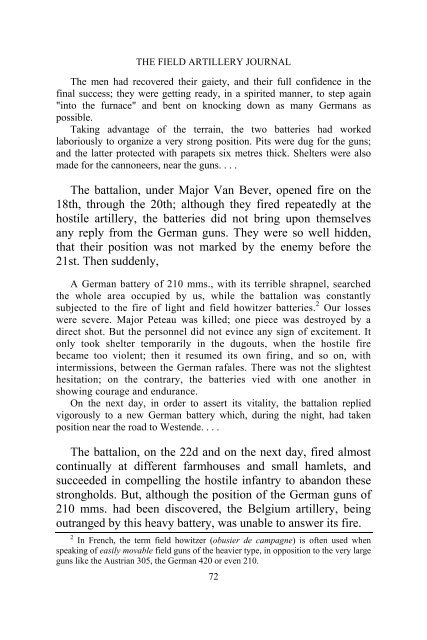the field artillery journal - Fort Sill - U.S. Army
the field artillery journal - Fort Sill - U.S. Army
the field artillery journal - Fort Sill - U.S. Army
Create successful ePaper yourself
Turn your PDF publications into a flip-book with our unique Google optimized e-Paper software.
THE FIELD ARTILLERY JOURNAL<br />
The men had recovered <strong>the</strong>ir gaiety, and <strong>the</strong>ir full confidence in <strong>the</strong><br />
final success; <strong>the</strong>y were getting ready, in a spirited manner, to step again<br />
"into <strong>the</strong> furnace" and bent on knocking down as many Germans as<br />
possible.<br />
Taking advantage of <strong>the</strong> terrain, <strong>the</strong> two batteries had worked<br />
laboriously to organize a very strong position. Pits were dug for <strong>the</strong> guns;<br />
and <strong>the</strong> latter protected with parapets six metres thick. Shelters were also<br />
made for <strong>the</strong> cannoneers, near <strong>the</strong> guns. . . .<br />
The battalion, under Major Van Bever, opened fire on <strong>the</strong><br />
18th, through <strong>the</strong> 20th; although <strong>the</strong>y fired repeatedly at <strong>the</strong><br />
hostile <strong>artillery</strong>, <strong>the</strong> batteries did not bring upon <strong>the</strong>mselves<br />
any reply from <strong>the</strong> German guns. They were so well hidden,<br />
that <strong>the</strong>ir position was not marked by <strong>the</strong> enemy before <strong>the</strong><br />
21st. Then suddenly,<br />
A German battery of 210 mms., with its terrible shrapnel, searched<br />
<strong>the</strong> whole area occupied by us, while <strong>the</strong> battalion was constantly<br />
subjected to <strong>the</strong> fire of light and <strong>field</strong> howitzer batteries. 2 Our losses<br />
were severe. Major Peteau was killed; one piece was destroyed by a<br />
direct shot. But <strong>the</strong> personnel did not evince any sign of excitement. It<br />
only took shelter temporarily in <strong>the</strong> dugouts, when <strong>the</strong> hostile fire<br />
became too violent; <strong>the</strong>n it resumed its own firing, and so on, with<br />
intermissions, between <strong>the</strong> German rafales. There was not <strong>the</strong> slightest<br />
hesitation; on <strong>the</strong> contrary, <strong>the</strong> batteries vied with one ano<strong>the</strong>r in<br />
showing courage and endurance.<br />
On <strong>the</strong> next day, in order to assert its vitality, <strong>the</strong> battalion replied<br />
vigorously to a new German battery which, during <strong>the</strong> night, had taken<br />
position near <strong>the</strong> road to Westende. . . .<br />
The battalion, on <strong>the</strong> 22d and on <strong>the</strong> next day, fired almost<br />
continually at different farmhouses and small hamlets, and<br />
succeeded in compelling <strong>the</strong> hostile infantry to abandon <strong>the</strong>se<br />
strongholds. But, although <strong>the</strong> position of <strong>the</strong> German guns of<br />
210 mms. had been discovered, <strong>the</strong> Belgium <strong>artillery</strong>, being<br />
outranged by this heavy battery, was unable to answer its fire.<br />
2<br />
In French, <strong>the</strong> term <strong>field</strong> howitzer (obusier de campagne) is often used when<br />
speaking of easily movable <strong>field</strong> guns of <strong>the</strong> heavier type, in opposition to <strong>the</strong> very large<br />
guns like <strong>the</strong> Austrian 305, <strong>the</strong> German 420 or even 210.<br />
72

















